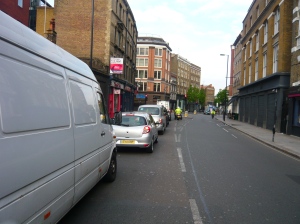“Cyclists & the Law” – biased and subjective impressions of the event
 I went to the ‘Cyclists and the Law’ panel discussion at City Hall the other night. It was a little disconcerting to find myself back in the cycle-campaigning fold, however slight my current association to any cycle-campaign group is. I wasn’t surprised to see that Dr. Robert Davis is still well capable of clearing any buffet put before him, but I was pleasantly surprised to see some new faces in the otherwise familiar crowd of old friends. The formal outcome of the evening I’ll leave for another post. (Updated: a fairly complete account of the proceedings was forwarded by Jenny Jones’ office.) I wanted to put down some opinions and impressions.
I went to the ‘Cyclists and the Law’ panel discussion at City Hall the other night. It was a little disconcerting to find myself back in the cycle-campaigning fold, however slight my current association to any cycle-campaign group is. I wasn’t surprised to see that Dr. Robert Davis is still well capable of clearing any buffet put before him, but I was pleasantly surprised to see some new faces in the otherwise familiar crowd of old friends. The formal outcome of the evening I’ll leave for another post. (Updated: a fairly complete account of the proceedings was forwarded by Jenny Jones’ office.) I wanted to put down some opinions and impressions.
Andrew Gilligan is very impressive. I was initially very sceptical of his new calling, viewing his appointment as ‘cycling tsar’ (his ironic title) as a crony sinecure, and doubting his ability to make real changes, but I was very wrong. He appears to have mastered the brief (get more people cycling), and is committed to evidence-based policy, as opposed to anecdotal subjective stuff, such as we have seen from Boris before. As was said in our chat on the Bike Show, I estimate that this is because Boris was genuinely dismayed by how badly he was received in the cycling hustings before the last election, and realises that he has to do something serious and substantial if he is not, in the words of Sonia Purnell, to be seen to have failed London’s cyclists. I was especially struck by the fact that Jenny Jones of the Green Party, who was chairing the discussion, was pretty fulsome in her praise of him, and Jenny is usually very selective in her use of praise.
People use statistics in a very slap-dash way, even people from a well-educated and well-briefed audience such as this. One chap got up and said that no cyclists get killed in Paris, which is a big load of pony, complete and utter rubbish. He used the 2011 ‘Paris 0 London 16’ canard, which I discussed in one of my first posts. He also seemed totally unaware that 5 cyclists were reported killed in Ville de Paris in 2012 (remember that Ville de Paris is much, much smaller jurisdiction than Greater London, roughly equivalent to Zone 1). From this I deduce that he got the numbers from the media reports last year about the garbled Paris numbers, which shows the danger of taking statistics from secondary sources, and not looking a bit harder to find out what the real story is.
I find it totally reprehensible that people use whatever dodgy number comes to hand to make a case, no matter how unreliable the number may turn out to be.
Detective Chief Superindent Wilson also used what I thought was a questionable metric to support his assertion that UK traffic police have nothing to learn from their continental counterparts about reducing road death and injury. The metric was road deaths per head of population. He had the UK (I think it was UK, but may have been England & Wales) at 31 per million, Germany at 49 & France at 61. I’d like to see this number correlated against average vehicle speed, modal share, total distance travelled at the very least for a like-by-like comparison. The number by itself is far too crude a measure to tell us anything very much.
I read somewhere (apologies for lack of source!) that France has 5 times the length of road as the UK, which seems plausible, as France is much, much bigger topographically. With roughly the same number of vehicles, this is likely to mean much higher average speeds, which in turn is likely to lead to increased injury and death. This is not the result of the UK’s authorities doing anything particularly clever, just the natural outcome of having congested roads on which it is not often possible to go very fast.
20 miles per hour speed limits are really important. David Arditti thinks they are virtually irrelevant, as he has again said, to the goal of achieving mass-cycling (no need to call me ‘Chidley’, David, you can just call me ‘Bill’), but Wednesday night showed me that if you are interested in getting more people cycling, you need to support 20 mph limits. All the walking organisations, and especially those representing special interest groups like Guide Dogs, are passionate supporters of 20 mph limits.
Darren Johnson, chair of the London Assembly, who said during the evening that there was a growing cross-party consensus in the Assembly forming behind the ‘cycling agenda’ isn’t a cyclist. He doesn’t use a car at all, as far as I know, but, like most Londoners, uses public transport to get around. He is very, very concerned that the pro-cyclist agenda does not impede or impinge in any way on pedestrians and public transport users.
 At some point, bicycle lanes will start to interfere with buses, if a segregated and safe bicycle path is built alongside every main road, as David Arditti is pressing for. When the narrow width of some of London’s main roads is raised as a potential obstacle, the ‘Go Dutch’ answer is to lose a motor-carriageway, making the road 2-way for cyclists, but one way for motor traffic, and diverting the other carriageway to some other street. As I said before, this is likely to be necessary on parts of Clerkenwell Road. This will inevitably mean diverting buses around a longer route. Given that the Bus must always get through, to borrow a phrase from the 1920s, at least as far as TfL seems to be concerned, this is likely to be a sticking point, and not a minor one either. To push major alterations to the London transport network such as this through will require lots of political will and support. Given that cycling is in a single figure minority, it will require the help of other groups apart from cyclists, such as those representing pedestrian interests. It is therefore very, very unwise to go around saying that 20 mph limits are irrelevant or unimportant to cyclist’s interests.
At some point, bicycle lanes will start to interfere with buses, if a segregated and safe bicycle path is built alongside every main road, as David Arditti is pressing for. When the narrow width of some of London’s main roads is raised as a potential obstacle, the ‘Go Dutch’ answer is to lose a motor-carriageway, making the road 2-way for cyclists, but one way for motor traffic, and diverting the other carriageway to some other street. As I said before, this is likely to be necessary on parts of Clerkenwell Road. This will inevitably mean diverting buses around a longer route. Given that the Bus must always get through, to borrow a phrase from the 1920s, at least as far as TfL seems to be concerned, this is likely to be a sticking point, and not a minor one either. To push major alterations to the London transport network such as this through will require lots of political will and support. Given that cycling is in a single figure minority, it will require the help of other groups apart from cyclists, such as those representing pedestrian interests. It is therefore very, very unwise to go around saying that 20 mph limits are irrelevant or unimportant to cyclist’s interests.
The Cycle Task Force nick a lot of cyclists. I was shocked by the numbers, really shocked. The breakdown was 50% motor-vehicles, 26% HGV & PSVs and 24% cyclists, which seems an awful lot of cyclists, given how little injury is caused by bicycles.
I’m not suggesting that London cyclists are paragons of law-abiding road-users. In fact, I have argued elsewhere that because the laws of the road manifestly do NOT protect law-abiding cyclists, it makes no sense to obey the law, because the laws aren’t there to keep cyclists safe, they are there to make motorists life easier. On reflection, however, there may be something in these numbers that is really interesting. The share may actually be yet another indicator of how many of the vehicles in central London are bicycles. That is probably a number for someone with a very big brain, like Geography Jim, over at Drawing Rings blog to crunch.
It’s not a great idea to suggest to a bunch of hardened cycle-campaigners that they should be wearing helmets. Kevin O’Sullivan of Levene’s solicitors suggested that it might be, and he was lucky to escape with his life. There were howls, full-throated wails, of protest at this. Top marks for courage, zero marks for wisdom.

I plead not totally guilty. As the photo shows, there is some food left in front of me and the only person eating it owns the hand at the right hand side of the picture, and it is not mine.
On a more serious note, I had a long chat with the esteemed author about close overtaking and those incidents defined as close proximityy incidents. I have since sent him all the relevant information I have – but don’t know if I used the rigth e-mail address.
Did you get the info. Bill?
LikeLike
No, I didn’t. Email address is bill.chidley at gmail dot com.
LikeLike